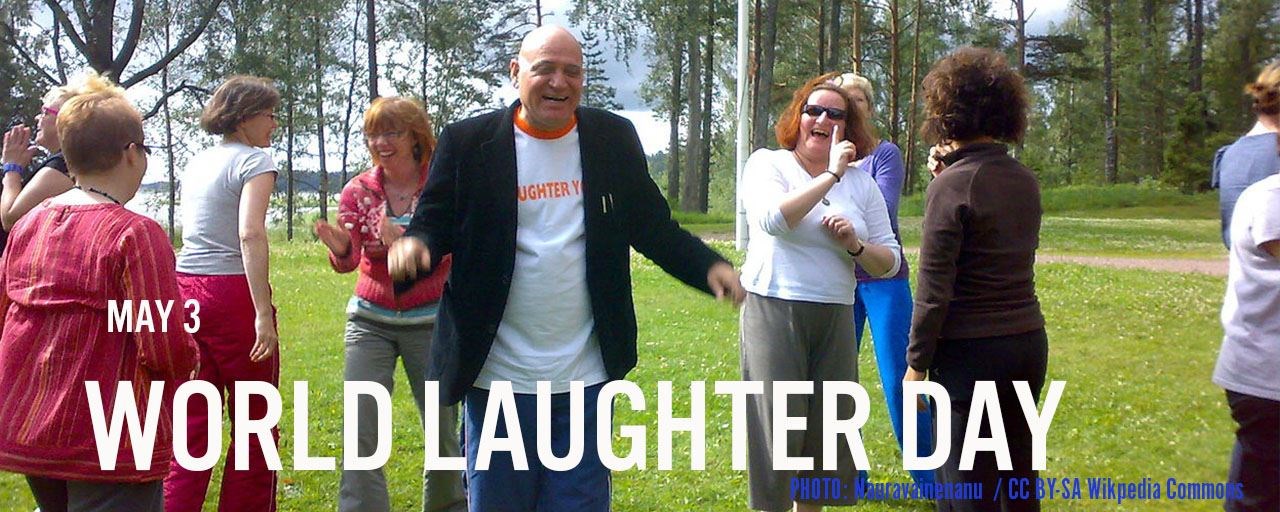This multi-media curated teacher resource includes discussion guide and learning outcomes for World Laughter Day, which aims to build global friendships through the science of laughter. Share the importance of laughter with your students.

In this lighthearted lesson plan, students read stories and watch films about World Laughter Day and its founder, Dr. Kataria. Students will learn about the scientific research behind the positive benefits of laughter.
Laughter Yoga is a movement Dr. Kataria started over 20 years ago, where people assemble in groups just to laugh. As infectious as laughter itself, Laughter Yoga is now practiced around the world.
Ask students what the sources of stress are in their lives. What makes them feel bad, angry or sad?
Then ask what their experiences with laughter have been. Have they ever been unable to stop laughing? Have they laughed so much their sides hurt of their faces hurt from smiling?
If possible, have students watch a video of schoolchildren laughing (0:06-0:30)
Ask if the sound of laughter makes them want to laugh!
Story | Dr. Karatani - Founder of Laughter Yoga

The following questions can be used as classroom discussion prompts or essay questions. Students may be directed to read the embedded links to the American Psychology Association as well as the Mayo Clinic to answer questions 4, 5 and 6.
1. Do we need comedy to laugh? What scientific principle is laughter yoga based on? (The body doesn’t differentiate between spontaneous and deliberate laughter.) What makes something funny?
2. Dr. Kataria started his first laughter club by approaching strangers in the park. At first they thought he was crazy. Are you also skeptical about laughter yoga? If so, why?
3. What medical case impressed Dr. Kataria and got him thinking about starting a laughter club?
(Hint: In his book, Anatomy of an Illness, the American journalist Norman Cousins describes how he laughed his way out of an incurable disease of the spine - Ankylosing Spondylitis.)
4. Chronic stress is linked to what six leading causes of death? [Students should read the external link to the American Psychology Association website: Heart disease, cancer, lung ailments, accidents, cirrhosis of the liver, and suicide.)
5. How does laughter boost the immune system? [Students should read the external link to the Mayo Clinic website: Negative thinking actually creates chemical reactions in your body. The increase of stress-related chemicals decrease the effectiveness of your immune system. Positive thoughts (including laughter) can create chemicals called neuropeptides that decrease stress and prevent illnesses.]
6. What are some short term benefits of laughter? [Students should read the external link to the Mayo Clinic website (1) Stimulates internal organs through intake of oxygen (2) Activates and relieve your stress response (3) Soothes tension by stimulating circulation and aiding muscle relaxation.
6. Who is Dr. Kataria’s hero, and why?
Film | Laughter Yoga: Laughing for Fitness

In this 60 second video, Jeffrey Briar trains members of the Laughter Yoga Institute, a laughing club in Laguna Beach, California that works on the principle that the body cannot differentiate between “real” and deliberate laughter.
(1) What scientific principle is laughter yoga based on? Why do we not need comedy to laugh?
(Hint: The body doesn’t differentiate between spontaneous and deliberate laughter.)
(2) What does Jeffrey Briar say is the single most positive thing he gets from his laughter yoga club?
(3) Why do you think the club members have become his strongest friends?
Watch i Luv Laughing Yoga.
(1) Why did Dorothy found Laughing Yoga so helpful in her life?
(2) How do you feel when you see the club members practicing Laughing Yoga?
(1) Have the students participate in the HA-HA-HO-HO-HA exercise shown at 3:03.
(2) Have them make eye contact and/or be silly.
(1) How do you feel? Better, worse, the same? Knowing what you do now about the practice of laughter, do you think you will try to keep practicing laughter for the benefits?
(2) If strangers can laugh together, and become friends, what are the implications for the world? What example does Dorothy raise about world peace?
(3) Do you think you will use the practice of laughter during the moments of stress you identified earlier in the lesson?
Students will gain familiarity with the concepts of deliberate and spontaneous laughter, the health practice of laughter and the scientific research supporting the practice. Students will consider how laughter can contribute to friendships, as well as friendship on a global scale. Students may also identify sources of stress in their lives, and how to incorporate the practice of laughter for its benefits.
Laughter Yoga is a movement Dr. Kataria started over 20 years ago, where people come together just to laugh. As infectious as laughter itself, it is Laughter Yoga is now practiced around the world in 65 different countries. Why is laughter something to study?
According to a March 14, 2019 article in Education Week, rates of reported symptoms of depression in teens and young adults has increased while rates for older adults have remained about the same, indicating this is a problem that afflicts younger generations only. Causes may be attributable to cultural and technological changes over the past decade like social media, the use of smartphones, as well uncertain career outcomes due to economic issues. Schools are increasing training for teachers to identify these symptoms, as well as to promote healthy habits. Students can track their sleep, water and food intake to learn how they contribute to their well-being. Social-emotional learning programs that teach students to manage their emotions or to identify symptoms of suicidal thoughts in their peers are also on the rise.
Another healthy practice that can be shared with students is laughter.
The Facial Feedback Hypothesis theory is a theory in the psychological sciences, originating with Charles Darwin and developed by William James, which says a facial movement can create a genuine emotion. They aren't just reflections that we are feeling happy, but can make us feel happier.
For example: When scientific test subjects are made to put pencils or sticks between their teeth to create a smile, they report an increase in positive mood. Similarly, when people laugh--they also feel better.
According to this Huffington Post article on World Laughter Day: "You can trigger laughter spontaneously, without jokes by following a set of behavioral rules. The most common sound for laughter is the familiar sound: 'Ha ha ha.' I know it sounds a bit ridiculous, but a team of British neuroscientists determined that even remote Northern Namibian tribes, which have had virtually no contact with the outside world, use this sound to laugh, meaning it may be a human universal. The 'ha, ha, ha,' it appears, is in our DNA."
Learn more about the history of laughter therapy with the external links below.

Online Laughter University
More laughter exercises. OLU's mission is to integrate laughter into wellbeing solutions at home and at work.
Organizer created on 4/24/2019 1:28:31 PM by Xenia Shin
Last edited 5/3/2020 12:20:24 AM by Shannon Luders-Manuel